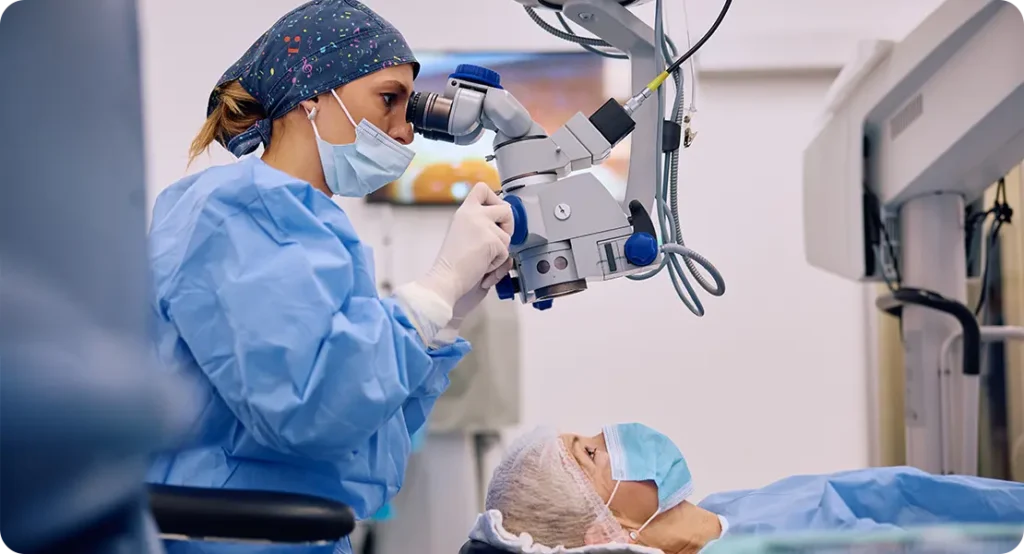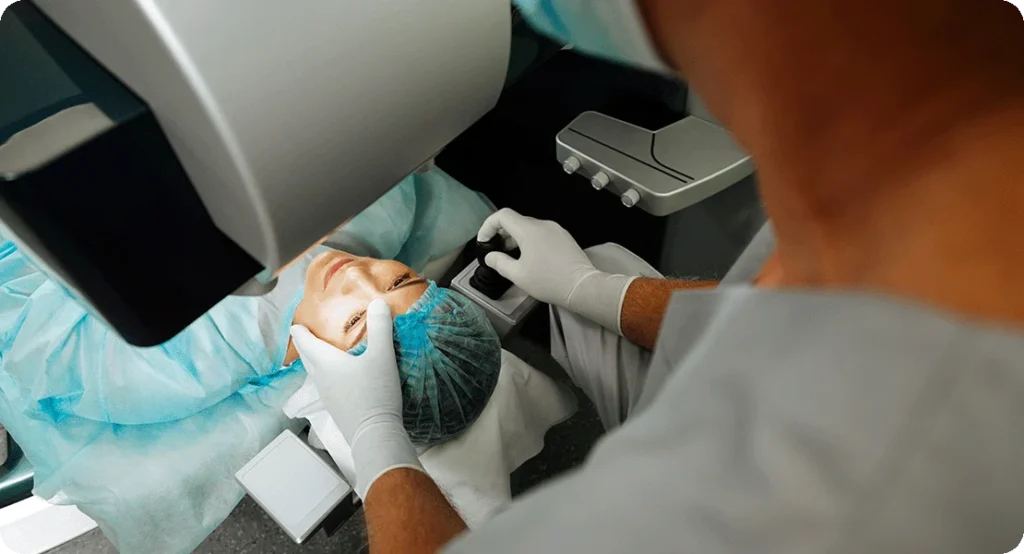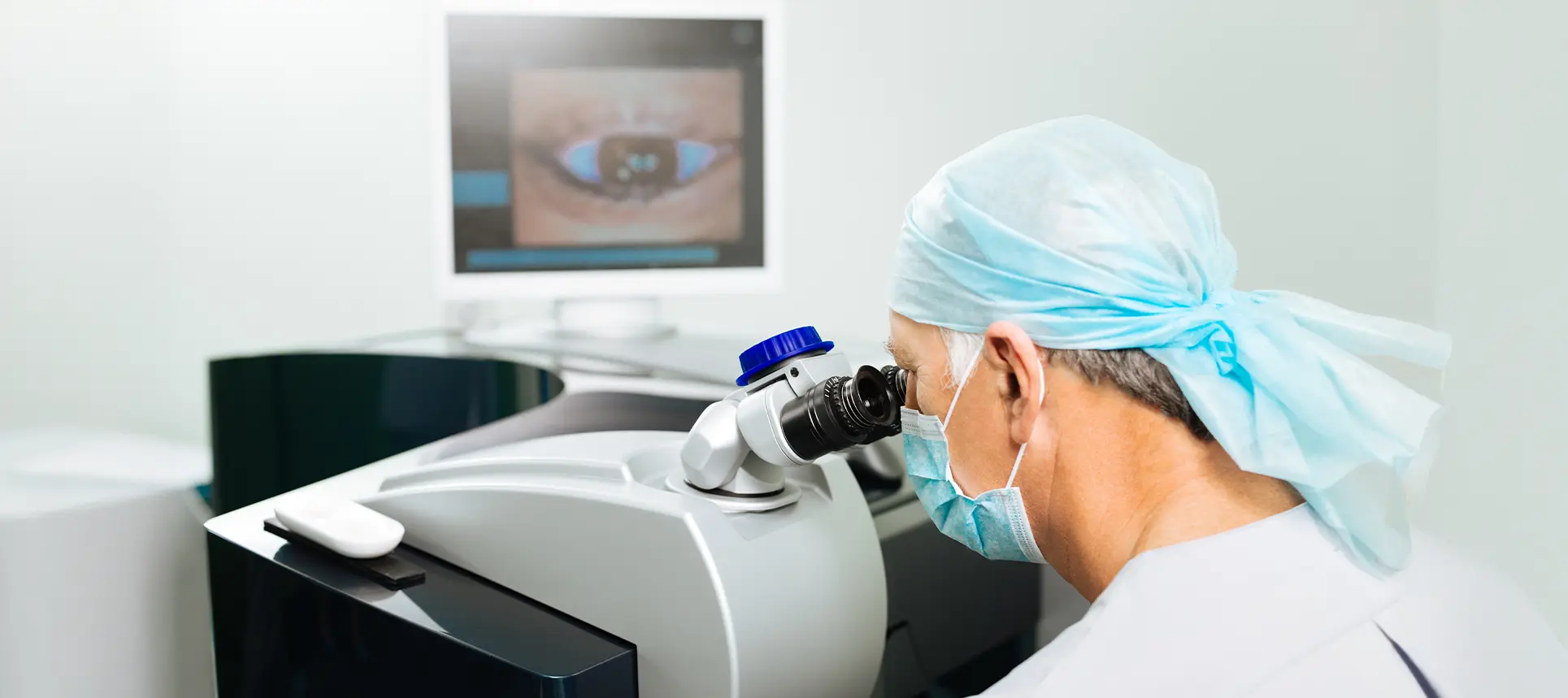If you’ve been told you need cataract surgery and suddenly find yourself bombarded with terms like “premium lenses” or “premium cataract surgery”, you’re not alone. It’s completely normal to feel a bit overwhelmed. After all, no one wants to make the wrong decision when it comes to their eyesight. So, let’s break it all down in simple, straightforward terms and help you decide whether premium cataract surgery is genuinely worth the extra cost—or if standard treatment will do just fine for your needs.
The Basics: What Happens During Cataract Surgery?
Before we dive into what makes a cataract surgery “premium”, let’s quickly go over the basics. Cataracts occur when the natural lens in your eye becomes cloudy. This cloudiness gradually affects your vision, making it harder to read, drive, or see clearly in bright light.
During cataract surgery, this cloudy natural lens is removed and replaced with a clear artificial lens, called an intraocular lens (IOL). It’s usually a quick and safe procedure that can dramatically improve your vision—and in many cases, it’s done under local anaesthetic as a day case.

Now, here’s where things start to branch off: the type of IOL you choose and the technology used during your surgery are what determine whether you’re having standard or premium cataract surgery.
What Exactly Is ‘Premium’ Cataract Surgery?
So, what makes a cataract operation “premium”? In essence, it boils down to three things:
- Advanced lens options
- Newer surgical techniques or technology
- A more personalised approach to vision correction
Let’s unpack each of these a little more.
Certainly! Here’s an expanded and fully original version of each bullet point with three paragraphs per lens or technique, using a direct conversational tone and UK English:
1. Advanced Lens Options
Multifocal lenses
Multifocal lenses are designed to address more than just long-distance vision. Unlike monofocal lenses, which offer clarity at a single focal point, multifocal lenses incorporate multiple zones of focus built into the lens itself. This means you could see clearly at near, intermediate, and far distances without constantly switching between different pairs of glasses.
One of the biggest appeals of multifocal lenses is the freedom they can offer in everyday life. Reading a book, using your phone, cooking, or watching TV can all become more seamless when your eyes are naturally equipped to handle various visual ranges. While some people do report slight visual artefacts like halos around lights at night, many adapt well over time and find the overall improvement in independence to be well worth it.
They’re especially popular among people with active lifestyles who don’t want to rely on reading glasses or varifocals. If you’re someone who moves fluidly between tasks that require near and far focus—like reading recipes while checking something across the kitchen—multifocal lenses could bring a genuine sense of ease to your day-to-day routine.
Extended Depth of Focus (EDOF) lenses
EDOF lenses work by elongating your range of clear vision, rather than giving you sharply defined focal points. This means your focus transitions more naturally between distances, particularly those in the intermediate range. They’re especially helpful for activities like working on a laptop, using a tablet, or engaging in hobbies that demand attention at arm’s length.
Compared to multifocal lenses, EDOF lenses are often associated with fewer issues such as glare or halos, especially when driving at night. This makes them a good middle-ground option for those who want more visual flexibility but are cautious about potential optical side effects. You might not get quite as crisp near vision as with a traditional multifocal, but for many, that’s a worthwhile trade-off.
These lenses tend to appeal to professionals and creatives who spend hours engaging with screens or hands-on projects. If your typical day involves typing emails, editing photos, or sketching designs, EDOF lenses can support these tasks without making your eyes feel strained or fatigued.
Toric lenses
Toric lenses are a standout option for people who have astigmatism—a condition where the cornea has an irregular shape, leading to distorted or blurred vision. While monofocal lenses don’t correct for this issue, toric lenses are specifically shaped to compensate for the asymmetry, offering sharper and more accurate vision.
The beauty of toric lenses lies in their ability to improve visual clarity at a single distance while also reducing the visual distortion caused by astigmatism. That’s a double win for many patients, especially if their pre-existing astigmatism was affecting tasks like reading signs, recognising faces, or watching TV. With toric lenses, you get a more natural visual experience and often a noticeable improvement over standard lens implants.
They are an especially good option for people who’ve struggled with glasses or contact lenses for astigmatism for years. By dealing with the root issue at the time of cataract surgery, toric lenses can offer a cleaner and more lasting visual result—saving you from needing specialised spectacles down the line.
Accommodating lenses
Accommodating lenses are designed to mimic the natural focusing ability of a younger eye. These lenses can shift slightly forward or backward in response to your eye muscles, allowing you to change focus between distances. Although the extent of accommodation can vary from person to person, many find this option appealing for its attempt to restore a more dynamic range of vision.
In practice, accommodating lenses tend to perform well for intermediate and far vision, but near vision may still require occasional use of reading glasses. However, users often find that tasks like looking at your phone, checking a menu, or even applying makeup feel more intuitive and less frustrating than with a standard monofocal lens.
What makes these lenses particularly interesting is their more “natural” approach to vision. Instead of splitting light into zones like multifocal lenses do, accommodating lenses aim to restore the eye’s natural focusing process. For some patients, this leads to a smoother visual experience with fewer issues like halos or glare.
2. Newer Surgical Techniques
Femtosecond laser-assisted surgery
Femtosecond laser-assisted cataract surgery is an alternative to traditional manual techniques, using a laser to carry out certain steps of the procedure such as making incisions and softening the cataract. This approach offers a high level of precision, which can be particularly helpful in certain cases where detailed planning or specific lens positioning is required.
While not necessarily superior to manual methods in terms of final visual outcomes for every patient, the laser can offer added control for the surgeon, especially when working with more complex lens types like toric or multifocal implants. In some cases, this may help improve consistency or ease lens placement, although it does not guarantee a better result overall.

Some patients may also benefit from a gentler surgical experience, as the laser can reduce the amount of ultrasound energy needed to break up the lens. However, it’s worth noting that both traditional and laser-assisted cataract surgeries are considered highly safe and effective, and the choice often comes down to surgeon preference, patient suitability, and availability of equipment.
sections for balance or clarity!
Intraoperative aberrometry
Intraoperative aberrometry might sound a bit technical, but it’s really just a clever tool used to take live measurements of your eye during the surgery itself. These real-time calculations help the surgeon fine-tune the exact power and placement of the IOL being implanted, especially in complex cases or when a patient has had previous eye surgery like LASIK.
One of the biggest benefits of this technique is the improved accuracy it offers. Even the most thorough pre-operative measurements can be slightly off once you’re on the operating table. Aberrometry fills in the gaps by adjusting in the moment, providing a personalised correction that’s more aligned with your real-time eye structure and fluid pressure.
For patients choosing premium lenses, especially toric or multifocal types, intraoperative aberrometry can significantly enhance satisfaction by helping to hit the “sweet spot” for focus. When you’re investing in premium technology, the added precision offered by this technique can help ensure you’re getting the best possible visual result.
Image-guided systems
Image-guided systems use pre-operative scans of your eye to guide the surgeon during the operation, much like a GPS system. These high-resolution images are overlaid onto a real-time view of your eye during surgery, helping the surgeon make precise decisions in terms of where to make incisions and exactly where to place the lens.
This level of guidance is particularly useful for implanting complex lenses like toric IOLs, where even a slight rotational misplacement can significantly reduce effectiveness. It’s also valuable for multifocal lenses, which require precise centration in the visual axis to deliver the full range of benefits they’re designed for.
For patients, the real advantage is consistency. When every step of the procedure is aligned to detailed scans and digital markers, the chance of variability goes down. That’s the kind of reassurance that many people appreciate—especially when making a once-in-a-lifetime decision about their eyesight.
3. Customised Vision Correction
Customised vision correction is what really sets premium cataract surgery apart from the standard approach. Instead of a one-size-fits-all solution, you’ll be offered a tailored experience from start to finish. This usually starts with a thorough consultation where your visual habits and preferences are carefully explored.
You’ll often be asked questions about how you use your eyes every day—whether you spend more time reading, driving, using computers, or playing sports. This lifestyle-driven approach allows your surgeon to recommend a lens and surgical technique that aligns closely with how you live your life. It’s a far cry from the blanket approach used in standard NHS procedures.
You might also undergo additional diagnostic tests such as corneal mapping, contrast sensitivity analysis, and tear film assessments. These tests help paint a fuller picture of your eye’s unique characteristics. With this level of customisation, the goal isn’t just to give you better sight—it’s to give you better quality of sight that truly complements your daily activities and future aspirations.
Premium Cataract Surgery vs Standard: A Quick Comparison
| Feature | Standard Cataract Surgery | Premium Cataract Surgery |
| Lens Type | Monofocal | Multifocal, EDOF, Toric, Accommodating |
| Technology Used | Manual techniques | Laser, aberrometry, image guidance |
| Vision Outcome | Corrected for one distance | Can correct multiple distances and astigmatism |
| Glasses Required | Often for near or intermediate | Reduced or minimal dependence on glasses |
| Cost | Typically covered by NHS/private insurance | Additional out-of-pocket costs |
| Personalisation | Basic | Highly tailored to individual needs |
Is Premium Cataract Surgery Worth the Money?
This is the million-pound question, isn’t it? Whether it’s worth going premium depends on your priorities, lifestyle, budget, and how much you value visual independence.
Think About Your Day-to-Day Activities
If you’re someone who reads a lot, drives frequently at night, or uses multiple screens, you might benefit significantly from premium lenses. Multifocal or EDOF lenses can free you from constantly switching between different pairs of glasses. That convenience alone can be a game-changer.

On the other hand, if you don’t mind wearing reading glasses and your day-to-day vision needs are relatively simple, standard cataract surgery might be more than sufficient.
Consider Your Tolerance for Optical Side Effects
It’s important to understand that some premium lenses come with trade-offs. For instance, multifocal lenses can cause glare or halos around lights at night. While many people adapt over time, others find it bothersome.
Having a detailed discussion with your surgeon about the potential side effects is crucial. They can help guide you towards the lens that best fits your expectations.
Think Long-Term
Cataract surgery is a once-in-a-lifetime procedure for most people. The lens you choose will stay in your eye for the rest of your life. So, investing in a lens that gives you the best possible vision might be worth considering, especially if it enhances your quality of life every single day.
It’s not just a cost—it’s an investment in how you see the world.
Common Myths About Premium Cataract Surgery
Let’s tackle a few common misconceptions.
“Premium lenses are only for cosmetic reasons.”
Not at all. While it’s true they aim to reduce the need for glasses, that’s not a superficial concern. Visual independence can significantly impact your lifestyle, confidence, and even safety—especially when driving or navigating unfamiliar environments.
“They’re not safe.”
Premium cataract surgery uses the same surgical principles as standard cataract surgery, which has one of the highest safety profiles of any medical procedure. The additional technology can enhance accuracy but doesn’t make the procedure inherently riskier.
“Everyone is a candidate.”
Unfortunately, that’s not quite true. Certain eye conditions like macular degeneration, glaucoma, or severe dry eye may limit your suitability for certain premium lenses. A thorough evaluation is necessary.
Who Should Seriously Consider Premium Cataract Surgery?
It’s not for everyone, but if you tick some of these boxes, you may want to explore the option seriously:
- You’re highly active and want to stay that way
- You do a lot of reading, driving, or close-up work
- You’ve got a strong dislike for wearing glasses
- You’ve had laser eye surgery in the past and want similar freedom
- You’re willing to invest more for long-term visual comfort

What Should You Ask Your Cataract Surgeon?
If you’re leaning towards premium cataract surgery, here are some questions worth asking:
- Am I a suitable candidate for multifocal or toric lenses?
- What type of lens would you recommend based on my lifestyle?
- What are the risks or side effects with these lenses?
- How much extra does the premium option cost, and what does that include?
- Is laser-assisted surgery necessary for better outcomes with premium lenses?
- Will I still need glasses for anything afterwards?
Asking the right questions puts you in a stronger position to make the right choice.
NHS vs Private: What’s the Difference?
In the UK, standard cataract surgery is available on the NHS, which is brilliant. But it’s important to know that premium lenses and many of the technologies mentioned above are not covered. If you want these options, you’ll likely need to go private.
Going private usually means:
- More flexibility in choosing surgery dates
- A wider choice of lens options
- Access to advanced imaging and surgical technology
- Continuity with a consultant of your choice
But yes—it comes with a price tag. Costs can range from £2,500 to £4,000 per eye, depending on what’s included.
Final Thoughts: Should You Go Premium?
Choosing between standard and premium cataract surgery isn’t always a black-and-white decision. It comes down to what’s important to you. Are you looking for clear, functional vision that gets the job done? Or would you like to maximise your vision across all distances and minimise your dependence on glasses?
Premium cataract surgery can offer outstanding results, but it’s not automatically the right choice for everyone. Make sure you have a thorough consultation, ask lots of questions, and weigh up your lifestyle needs and budget before deciding.
If you’re considering premium cataract surgery and want to explore your options in more detail, feel free to contact our clinic to book a consultation with one of our expert private cataract surgeons—we’re here to help you make an informed, confident choice.
After all, this is your vision we’re talking about—arguably your most valuable sense. Taking the time to make the right decision is absolutely worth it.

